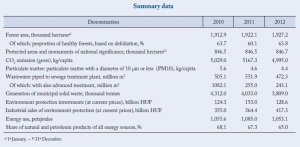Hungary – Environment and energ y
- Following a quick and overall reduction of air pollution at the end of the last century, among the air pollutants studied by the HCSO, the emission of hydro-fluoro-carbons (HFCs) and nitrogen oxides (NOX) rose, while the emission of the rest of them decreased or stagnated between 2000 and 2010.
- In respect of water, which is becoming an increasingly scarce resource, our country’s position is favourable: water resources per capita are about 12 thousand cubic meters per year, which is one of the highest volumes in Europe. At the same time, the distribution of the mass of water coming from across our country borders as well as the rainfall, is extremely uneven both in time and space.
- The proportion of settlements connected to the sewage system has grown from 27% to 56%, while the length of the sewage network per one kilometre of water pipes from 396 metres to 658 metres since 2000.
- The value of investments, created for environmental purposes, was the highest in 2005, from 2007 however it started to decrease and in 2011 was 18% less in real terms (HUF 129 billion) than in the previous year.
- In 2012, the country used 5% less energy. Domestic production decreased by nearly 2%, while energy imports by 3% compared to 2011.
- The domestic household electricity and gas prices are ones of the highest compared to the EU countries’ prices in purchasing power standards.
- Hungary uses a relatively lower amount of alternative sources in energy production compared to the EU average. The volume and the share of the electricity gained from renewable energy sources, in the total electricity production, decreased in 2011.
- The number of dwellings equipped with district heating remained unchanged, while the amount of sold heat decreased by 7.7% within a decade. The cause of the reduction is primarily the application programmes specifically targeting the energy efficiency increase for dwellings, which resulted in the renewal of nearly 300 thousand dwellings – equipped with district heating – since 2001.
Related articles
- Hungarian Central Statistical Office Report 2012. (Part 1) (budapest2014.wordpress.com)
- The Ignoble Struggle (theorangefiles.hu)
- Viet Nam, Hungary sign extradition agreement during president’s visit (vietnamnews.vn)
- Hungary-Russia relations enter new chapter at Budapest fair, Hungarian minister says (politics.hu)
- Hungarian invasion of Romania (footballatw.wordpress.com)
- Hungarian PM announces a further 10% reduction in utility costs: three questions (urban-energy.org)
- Tens of thousands had electricity and gas cut off over utility debts (politics.hu)
- Hungarian state media loses legal battle to keep details of costly TV “bomb” secret (politics.hu)
- DECC announce £6 million funding for local authority heat networks (aardvarknoseface.wordpress.com)
More:
Recorded on a national holiday/long weekend/bank holiday, hence the less crowded streets (lot of people leave the city for the long weekend). I could have chosen a different weekend I suppose, but I didn’t really think about that at the time 🙂
Premium: Budapest, Debrecen, Miskolc and more
